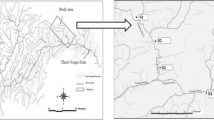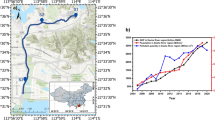Abstract
Estuarine ecosystem has greatly changed in the recent decades due to anthropogenic perturbations in the Changjiang Estuary. Change patterns and impact factors were analyzed based on the continuous data in relation to the Changjiang estuarine ecosystem from 1998 to 2012. The results showed significant decreases in plankton species and annual output of Coilia nasus, Coilia mystus. Furthermore, species and biomass of benthos showed abrupt change in 2003, downward before that and upward after that. It was noted that, Eriocheir sinensis, a high value commercial fish, had an annual production increase of 97%. Reduction of riverine nutrients, especially dissolved silicate (DSI) loads into the estuary could contribute to the decline in Bacillariophyta species. Dredging and dumping works of the North Passage led to the decreases in regional plankton species. However, the species reproduction and releasing projects could restore the estuarine ecosystem through increasing the output of E. sinensis, as well as species and biomass of benthos.
Similar content being viewed by others
References
Cardoso P G, Leston S, Grilo T F, et al. 2010. Implications of nutrient decline in the seagrass ecosystem success. Marine Pollution Bulletin, 60: 601–608
Chang N N, Shiao J C, Gong G C. 2012. Diversity of demersal fish in the East China Sea: implication of eutrophication and fishery. Continental Shelf Research, 47: 42–54
Chen Zhongyuan, Li Jiufa, Shen Huanting, et al. 2001. Changjiang of China: historical analysis of discharge variability and sediment flux. Geomorphology, 41: 77–91
Cheng Jiahua, Cheung W W L, Pitcher T J. 2009. Mass-balance ecosystem model of the East China Sea. Progress in Natural Science, 19: 1271–1280
Dai Zhijun, Du Jinzhou, Zhang Xiaoling, et al. 2011. Variation of riverine material loads and environmental consequences on the Changjiang (Yangtze) estuary in recent decades (1955–2008). Environmental Science and Technology, 45: 223–227
Dai Zhijun, Liu J T, Fu Gui, et al. 2013. A thirteen-year record of bathymetric changes in the North Passage, Changjiang (Yangtze) estuary. Geomorphology, 187: 101–107
Dauvin J C, Pezy J P. 2013. Long-term changes of the Seine estuary suprabenthos (1996–2012). Journal of Experimental Marine Biology and Ecology, 448: 93–103
Fan Qijin, Gao Min. 2009. Improvement project of deep-draft channel of Yangtze Estuary. Yangtze River (in Chinese), 40(8): 25–30
Fan Zhongya, Ge Jianzhong, Ding Pingxing, et al. 2012. Effect of the deep waterway project on the salinities in the north passage of the Changjiang Estuary. Journal of East China Normal University (Natural Science) (in Chinese), 4: 181–189
Fernando M, Henrique Q, Fernando M, et al. 2003. Zooplankton abundance in a coastal station off the Ria de Aveiro inlet (north-western Portugal): relations with tidal and day/night cycles. Acta Oecologica, 24: 175–181
Gao Shu, Wang Yaping. 2008. Changes in material fluxes from the Changjiang River and their impactions on the adjoining continental shelf ecosystem. Continental Shelf Research, 28: 1490–1500
Gardner M B. 1981. Effects of turbidity on feeding rates and selectivity of bluegills. Transactions of the American Fisheries Society, 110(3): 446–450
Golubkov S, Alimov A. 2010. Ecosystem changes in the Neva Estuary (Baltic Sea): Natural dynamics or response to anthropogenic impacts? Marine Pollution Bulletin, 61: 198–204
Jiang Weiwei, Liu Zhengwen, Guo Liang, et al. 2010. Experimental study on the effect of sediment resuspension on zooplankton community. Journal of Lake Science, 22(4): 557–562
Kibirige I, Perissinotto P. 2003. The zooplankton community of the Mpenjati estuary, a South African temporarily open/closed system. Estuarine, Coastal and Shelf Science, 58(4): 543–553
Korpinen S, Meski L, Andersen J H, et al. 2012. Human pressures and their potential impact on the Baltic Sea ecosystem. Ecological Indicators, 15: 105–114
Levine S N, Zehrer R F, Burns C W. 2005. Impact of resuspended sediment on zooplankton feeding in Lake Waihola, New Zealand. Freshwater Biology, 50(9): 1515–1536
Li Daoji, Daler D. 2004. Ocean pollution from land-based sources: East China Sea, China. Ambio, 33: 107–113
Li Maotian, Xu Kaiqin, Watanabe M, et al. 2007. Long-term variations in dissolved silicate, nitrogen, and phosphorus flux from the Yangtze River into the East China Sea and impacts on extuarine ecosystem. Estuarine, Coastal and Shelf Science, 71: 3–12
Liu H C, Shih C Y, Gong G C, et al. 2013. Discrimination between the influences of river discharge and coastal upwelling on summer microphytoplankton phosphorus stress in the East China Sea. Continental Shelf Research, 60: 104–112
Lougee L A, Bollens S M, Avent S R. 2002. The effects of haloclines on the vertical distribution and migration of zooplankton. Journal of Experimental Marine Biology and Ecology, 278(2): 111–134
McHugh J L. 1967. Estuarine nekton. In: Lauff G H, ed. Estuaries. Vol 83. Washington, DC: American Association for the Advancement of Science Special Publication, 581–620
McLusky D S, Elliott M. 2004. The Estuarine Ecosystem, Ecology, Threats and Management. 3rd ed. Oxford, UK: Oxford University Press, 224
Morgan C A, Cordell J R, Simestad C A. 1997. Sink or swim? Copepod population maintenance in the Columbia River estuarine turbidity-maxima region. Marine Biology, 129: 309–317
Mouny P, Dauvin J C. 2002. Environmental control of mesozooplankton community structure in the Seine estuary (English channel). Oceanologica Acta, 25(1): 13–22
Selleslagh J, Lobry J, Amara R, et al. 2012. Trophic functioning of coastal ecosystems along an anthropogenic pressure gradient: a French case study with emphasis on a small and low impacted estuary. Estuarine, Coastal and Shelf Science, 112: 73–85
Shanghai Environmental Monitoring Center (SEMC). 2011. Report of the integrated environmental assessment on the Changjiang Estuary Deep Water Channel Regulation engineering (2011–2012). http://www.semc.com.cn/
Shanghai Environmental Monitoring Center (SEMC). 2012. Report of the integrated environmental assessment on the Changjiang Estuary Deep Water Channel Regulation engineering (2011–2012). http://www.semc.com.cn/
Shen Guoying, Shi Bingzhang. 2002. Ocean Ecology. 2 ed. Beijing: Science Press
Smetacek V. 1998. Biological oceanography: diatoms and the silicate factors. Nature, 391: 224–225
SMM (The specification for marine monitoring Part 7: ecological survey for offshore pollution and biological monitoring). 2007. General Administration of Quality Supervision, Inspection and Quarantine of the People’s Republic of China. Beijing: Standards Press of China
Wang Baodong. 2006. Cultural eutrophication in the Changjiang (Yangtze River) plume: history and perspective. Estuarine, Coastal and Shelf Science, 69: 471–477
Yun Caixing. 2004. Evolutionary Rules of the Changjiang Estuary in Recent Decades. Beijing: China Ocean Press
Zeng Yonghui, Li Heyang, Jiao Nianzhi. 2007. Phylogenetic diversity of planktonic archaea in the estuarine region of East China Sea. Microbiologicl Research, 162: 26–36
Author information
Authors and Affiliations
Corresponding author
Additional information
Foundation item: The Funds for Ministry of Science and Technology of China (SKLEC); the National Natural Science Foundation of China under contact Nos 41076050 and 48505350; New Century Excellent Talents in University of China under contract No. NCET-12-0182.
Rights and permissions
About this article
Cite this article
Chen, D., Dai, Z., Xu, R. et al. Impacts of anthropogenic activities on the Changjiang (Yangtze) estuarine ecosystem (1998–2012). Acta Oceanol. Sin. 34, 86–93 (2015). https://doi.org/10.1007/s13131-015-0679-7
Received:
Accepted:
Published:
Issue Date:
DOI: https://doi.org/10.1007/s13131-015-0679-7




